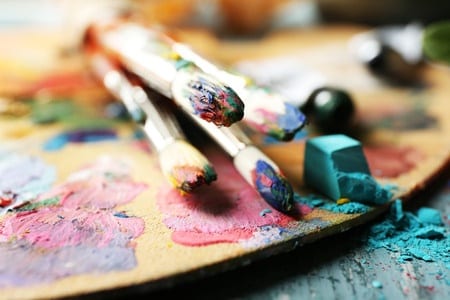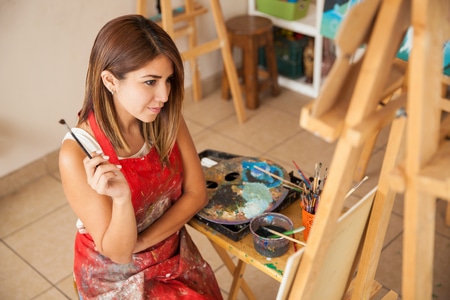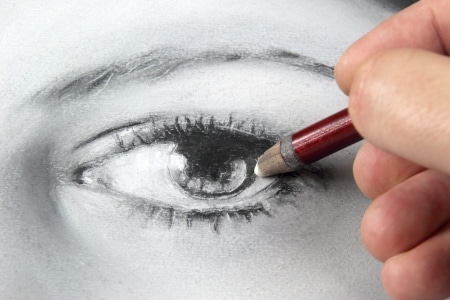 Contrary to popular belief, an understanding and knack for composition is not simply bestowed on each of us when we pick up our first drawing or painting utensil.
Contrary to popular belief, an understanding and knack for composition is not simply bestowed on each of us when we pick up our first drawing or painting utensil.
In fact, it’s an understanding that we must grow and cultivate over time, as we draw more and learn more about art.
Instead of presenting composition as some elusive theory that only artists who are hung in the halls of the Met understand, today we’ll look at what composition is, at its core, and how to improve yours in your own work.
What is composition?
Composition is, very simply put, the relation or arrangement of each of the elements that make up your painting.
It is not just the size relation between two objects that you’ve painted on a canvas, but also the uses of contrast for each element of your painting.
Contrast is important because it’s what makes art interesting to the human eye. Things like size, shape, hue and theme can add to your artwork’s contrast.
Why does composition matter?
Building a piece of artwork without considering the composition is like painting the walls in a room without checking to make sure you like the color.
Your work’s composition will have a huge impact on the product, so when you have a specific creation in mind—whether it’s a certain type of painting, or a photograph that evokes a singular emotion—you need to think about the composition before you dive in.
 To map out your work’s composition, start by imagining the frame of the picture or painting.
To map out your work’s composition, start by imagining the frame of the picture or painting.
The edges of the canvas that you’ll use are the first definition of composition that your work will have—a space of separation between that which is art and that which is not art.
If you want to paint a vase, for example, imagine or draw a small square thumbnail on a sheet of paper, and put the vase in the middle of the thumbnail. Now, draw a new thumbnail with the vase moved all the way over to the left so that it’s cut off out of the frame. Same to the right, top and bottom. Now, try one with the zoom pushed in on the vase, so you can’t see any negative space behind the painting, just the details on the vase.
Each version of those thumbnails is starkly different from the other. Depending on what you want your finished product to look like, choose the composition that you want to emulate in the final drawing.
You’ve just chosen your composition.
Does it have to look real?
Composition is important when you’re making art that looks like real life.
 If you’re doing a drawing of a little boy on a beach, the little boy should be proportionately-sized to where the viewer is standing, where the ocean waves are, and where the beach ball is.
If you’re doing a drawing of a little boy on a beach, the little boy should be proportionately-sized to where the viewer is standing, where the ocean waves are, and where the beach ball is.
If you draw the beach ball in the foreground with the little boy deep in the painting but make the head and the ball the same size, your painting’s composition won’t mirror real life.
Of course, if that’s what you want to achieve, then you’re good to go—but keep this in mind when you’re planning.
How do I create my composition?
If you’re not married to any certain idea of an end product, start by choosing a subject and a canvas size. Those first two steps will likely help to determine the composition that your painting should have.
The next thing you should think about is balance—balance positive and negative space so that your painting isn’t all of one and none of the other. It’s aesthetically pleasing to see balanced amounts of each.
Once you add contrast to catch the eye, choose your palate and get started, you’ll be well on your way to having a deliberately created piece of artwork.
Next steps: Follow through
The key to a great painting is follow-through on your original plan. You can deviate where needed, but if you’re hoping to achieve a desired effect, it’s a good idea to stick to what you first laid out in your thumbnail sketch. Think about where you want to draw your viewer’s eye and create a focal point.
And finally, all paintings should have variety. Change up some of the media or elements you’re working with to create variety that will keep your viewer engaged with your work.
If you’re interested in learning more, register for classes today at Hunakai Studio of Fine Arts. We offer several classes and workshops for adults in all media, from oil to colored pencils, and kids’ classes as well.
Work on your watercolor technique or learn how to make your own comic book. Whether you’re a seasoned artist that’s comfortable at the easel, or a beginner who is excited to learn, our classes are fun, engaging and informative.
Call us today at 508-543-5665 for more information, or register for any of our classes right on our website!